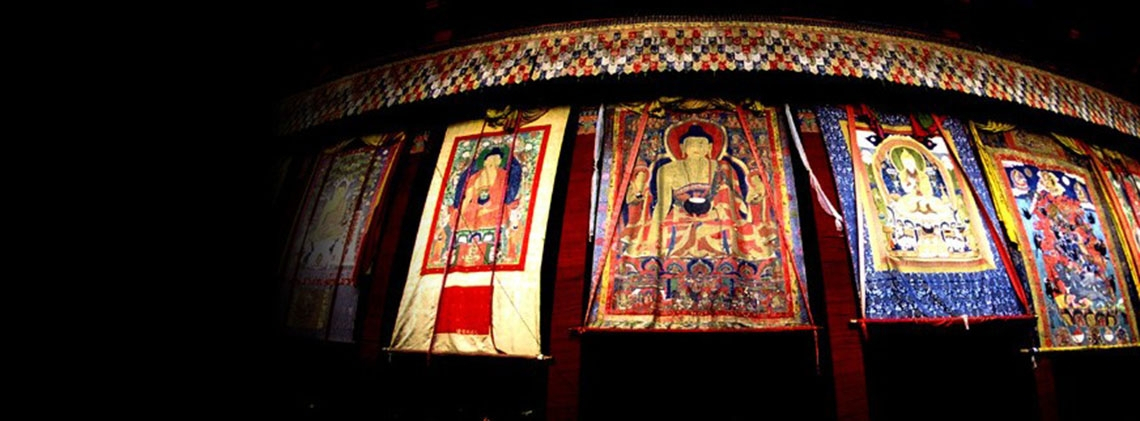
Tubo-Tibetan Culture
Splendid
Chi Culture
Topic
Tubo-Tibetan Culture
“Tubo” is a Chinese transliteration of “Boba” (Tibetan Bod-pa)—the name Tibetans called themselves during the Tang dynasty (618–907). The Tibetans live on the “roof of the world,” the world’s highest and largest plateau with snow-coverd mountains; this unique environment has helped form their distinctive Tubo culture.
Tibet’s colorful folkways are evident in their food, rituals, funeral practices, and festivals. The staple food in Tibet is tsampa, and butter tea is a daily drink. Furthermore, whether one is attending a red or a white affair (a wedding or a funeral), gathering with friends and relatives, receiving guests, or mediating disputes, the chhaang (highland barley beer) is indispensable.
Entering Tibet, colorful prayer flags fluttering in the wind, piles of mani stones universally engraved with the Sanskrit mantra (Om mani padme hum), Buddha images, and Buddhist scriptures are seen everywhere. All of these are unique Tibetan customs. To deepen one’s understanding of Tibet, one must know its traditions and rituals. For example, there are six different burial customs: sky burial, inhumation, cremation, stupa burial, water burial, and cliff burial. Among these, sky burial is the most popular.
Festivals are an essential element of Tibetan folk culture and have had their own special characteristics since ancient times. Major festivals include the Gama Rije (bathing festival), the Monlam (Great Prayer Festival), Losar (the Tibetan New Year), and the Shoton Festival.
In terms of religion, all Tibetans are religious. Tibetan Buddhism—Lamaism—is present in all aspects of Tibetan people’s lives. If one does not understand Tibet’s religion, it would be difficult to understand the people’s culture and customs. For example, some important beliefs to know are tulku (the belief in the reincarnation of certain believers, especially the Dalai and Panchen lamas), and Tibet’s sacred mountains and lakes. The Tibetan people had their own indigenous religion Bön before Buddhism was introduced to Tibet. The native religion was absorbed into Buddhism and later was supplanted by it. In the lengthy process of religious development, Tibetan Buddhism integrated with the Han Chinese and Indian cultures, and formed their own distinctive culture. Because all Tibetans are religious, many places of historic interest and scenic beauty are full of strong religious overtones, such as monasteries and temples, palaces and gardens, the king of sacred mountains—Kailas—and the three sacred lakes.
Speaking of culture and arts, one must mention thangkas. In Tibetan, “thangka” refers to a scroll painting made on colored satin fabric (a fact responsible for its alternate name, fabric painting). It is a type of drawing unique to Tibetan Buddhism. The themes found in the paintings are multifarious: religious, biographical, historical, genre, astronomical, medical, and anatomical. The artistic and economic value of these thangkas are quite high.
Tibetan operatic art combines various artistic forms into one, including songs, dances, and chants. Performances generally take place on a stage in a public square. Chants and songs, accompanied only by drums and cymbals, are two essential elements of Tibetan performing arts. Masks are the most prominent symbols of the art, and they can be classified into two types based on color: white and blue. The opera offers a rich repertoire of dramas, including eight major Tibetan woks: Princess Wencheng, Maiden Vgro-ba-bzang-mo, Prince Dri-med-kuniden, Maiden Shang, Brothers Don-yod and Don-grub, Prince Nor-bzang, Gzugs-kyi-nyi-ma, and Pad-ma-vod-vba.
There are two traditional divisions of the Tibetan Buddhist canon, Kangyur (or Kanjur) and Tengyur (or Tanjur). The former refers to the Buddhist teachings, ceremonies, and disciplines that Shakyamuni preached to his disciples; the latter refers to the translated treatises, which include commentaries and works of Tibetan schlars on Buddhist teachings. The voluminous and comprehensive Tibetan Buddhist canon is an encyclopedia for studying Buddhism and Tibetan culture.



